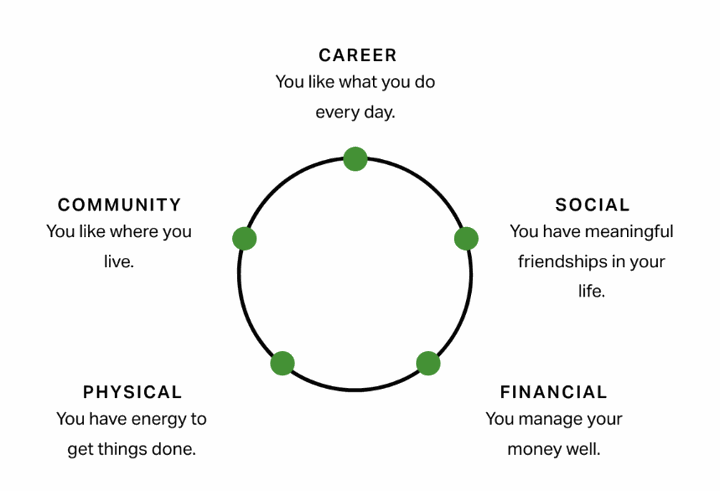Back in the day, the accepted norm involved employees going to work at 9 a.m. and clocking out at 5 p.m. There was no talk of work-life balance or finding happiness and satisfaction in the workplace. A career was seen as utilitarian, a means to an end to pay the bills.
Now, everything has shifted.
Work seeps into our personal lives and vice versa. Many of us work at night and on the weekends, and some of us never go a day without at least answering a work email or Slack message.
At the same time, since work and our personal lives have become so intertwined, employee well-being has become a major concern as five generations of the workforce grapple with what matters most to them.
Employee wellbeing, or employees’ overall health, is also at the top of mind for HR leaders. If you haven’t created an employee well-being program yet, now is the time.
Learning more about employee wellbeing and emphasizing it in your hiring and retention plans will positively contribute to employee productivity, happiness, and your bottom line.
Skip the Guide and Take a Tour of Compt
What is Employee Wellbeing?

Decades of Gallup research reveal 5 universal elements of wellbeing.
Employee wellbeing is the overall physical, emotional, mental, social, and financial health of your employees. It is also known as employee wellness and it attracts talented workers and retains the ones already working for you. It’s about preventing burnout and ensuring employees are healthy, happy, and have everything they need to thrive in the workplace.
Interestingly, workplace wellness is not a new concept. Bernardini Ramazzini, an Italian doctor who lived from 1633-1714, studied preventative measures that could be taken to improve workers’ wellbeing. However, with the Industrial Revolution starting soon over, productivity was more important than employees’ health. It wasn’t until the 1950s that employee assistance programs focused on wellness interventions, and then in the 1970s, the worksite health movement promoted employee fitness.
Employee wellbeing programs have become more and more important. They are increasingly holistic and incentivize employees to stay healthy while maintaining a work-life balance.
Why Does Employee Wellbeing Matter for HR Leaders?
Why is employee wellbeing so critical?
Having an employee wellbeing program is advantageous from both a business and personal standpoint.
A Gallup poll showed that poor employee wellbeing can result in a number of negative events, including:
- 15% to 20% average of total payroll in voluntary turnover costs due to burnout
- $20 million of additional lost opportunity for every 10,000 workers because of suffering or struggling employees
Gallup also reveals a difference between engaged and thriving employees. If an employee is engaged, but it not thriving in their wellbeing, they are 66% more likely to experience daily worry and 61% more likely to experience burnout often or always.
Essentially, if HR leaders are not investing in employee wellbeing, the employees and the company will suffer.
On a personal note, workplaces should be concerned about their employees’ health – not just about how much revenue they can generate.
With a shift in attitude, HR leaders and companies can provide a better workplace for their employees to ensure they are as healthy and satisfied as possible at work and beyond.
The Benefits of Employee Wellbeing
There are several advantages to employee wellbeing, which benefit the employees and HR teams. Some even contribute to a healthier and better-functioning society as a whole. The impact that a strong employee wellbeing program can have is truly limitless.
Lower healthcare costs
According to the Gallup poll, 75% of medical costs accrued mostly due to preventable conditions is one of the costs of poor employee wellbeing.
On the other hand, when employers emphasize taking time to go to the on-site gym, stocking the kitchen with healthy snacks, offering comprehensive healthcare, or providing fitness classes like yoga or pilates to employees, healthcare costs are going to be lower.
Higher employee engagement
When employers put their workers’ health at the forefront, workers are more likely to be engaged. This means they care about their work, they participate in meetings, they come in excited about what they’re doing, and they perform at a higher level. According to Engagement Multiplier:
Employees who are engaged and have high wellbeing are:
- 59% less likely to look for a job with a different organization in the next year
- 27% more likely to report “excellent” performance at work
- 30% more likely not to miss any days of work because of poor health in a given month
Less burnout
Burnout can lead to employees not being engaged with their work, suffering from mental, physical, and emotional ailments, and, ultimately, missing days of work or quitting a job. A well-rounded employee well-being program can combat burnout by providing employees with the right amount of time off and opportunities for relaxation. Instead of being ‘go, go, go’ and feeling like they’re on a perpetual hamster wheel, employees can take a healthier approach to work and get the space they need to breathe.
Reduced absenteeism
Mental, physical, and emotional ailments can cause employees to call out of work. Or, they may simply be bitter or upset that they are not getting the time off they need, and will take it on their own. According to DailyPat, employee wellbeing programs can reduce absenteeism – which costs about $2,650 each year for salaried employees. Workplaces with higher stress levels tend to experience more absenteeism. Employee wellbeing programs decrease absenteeism and, in turn, decrease expenses.
Better recruiting
Candidates looking for a new job don’t just care about the hours and salary. They also care about the benefits, including employee wellbeing programs. According to Glassdoor, 48% of U.S. workers said one of the top things they looked for in a new job was attractive benefits. If you and your competitors want to fill similar roles with similar pay, an employee wellbeing program could be why one candidate chooses your company over another. This is incredibly beneficial during the post-Great Resignation stage, where finding quality employees has become harder.
Higher retention
Along with attracting candidates, employee well-being programs can also lead to higher retention among workers. According to Forbes, 67% of employees who work for companies with wellness programs enjoy their jobs more and are “extremely or very likely to recommend their employer to others.” It costs an average of about $4,000 to hire a new employee, and companies suffer from a loss of productivity when trying to find someone to fill a role. If a company has a high turnover rate, it can hurt morale. When employee wellbeing is a priority, workers are more likely to stay in their positions for longer.
Better employer brand
People care deeply about an employer’s brand and culture when searching for a job. If a company has a strong employee wellbeing program, it shows that they care about its workers, making it easier to find candidates. It can also make current employees proud to work there and increase retention.
Components of a Successful Employee Wellbeing Program
When creating your employee wellbeing program, look at other employers and HR leaders who have been successful with their own. Typically, you’ll want to include a range of benefits, like the following.
Social wellness
When it comes to social wellness, emphasize and encourage charitable giving. For example, you could run a company-sponsored program where employees can give to a charity of their choice through payroll. These donations will be tax-deductible, so there is a benefit to the employee. This kind of program would likely be popular around the holiday season, but you could do it all year round.
Personal and professional development
Give your employees the chance to engage in both personal and professional development. Your employee wellbeing program could consist of sessions with a mentor or career coach, access to free courses, company-sponsored classes, and sponsored conferences that workers can attend.
Team events
Team-building is critical. Employees can come together, bond while participating in fun activities, increase their trust in one another, and improve their communication. Your company could hold company-wide retreats, take employees out for happy hour, or bring in outside consultants and entertainers for a day.
For instance, you could bring an improv teacher to teach your workers the principles of improv comedy, which teaches them how to work together and say “yes” to one another’s ideas.
Health and wellness
Health and wellness include both physical and mental health. From sponsoring gym memberships to holding weekly yoga classes and paying for therapy for your workers, these programs will help them avoid burnout and feel centered. Make sure that you have strong health insurance benefits in place as well.
Financial wellbeing
A financial wellbeing program will help employees learn about and better manage their money. For instance, you could pay for them to meet with a financial advisor, bring in a 401(k) specialist to help them choose a plan, and give them access to apps like Mint or You Need A Budget.
Occupational wellbeing
You want your employees to be happy at work, which is something you can accomplish through an occupational well-being program. Perhaps you could offer unlimited vacation days or allow employees to pick up their kids from school or go to their own doctors’ appointments when needed This one is all about work-life balance.
Why do Employee Wellbeing Efforts Fail?
Some companies want the best for their employees, but they don’t always know how to set up an employee wellbeing program that is actually going to be successful. When creating your own program, make sure you avoid these common pitfalls.
Lack of leadership buy-in
You will need not only the HR team but also the managers and C-suite executives on board. When presenting to your leadership team, ensure you include the benefits of an employee well-being program with key metrics and proof to back up your findings. Also, tie your program to business objectives, like addressing high turnover or not finding adequate candidates to fill critical roles.
Poor alignment of incentives
Your employee wellbeing program has to make sense for your company culture and demographics. For example, if your workers are typically younger, they may enjoy happy hours, but if they are older and have children, they will value their time off more. You must incorporate employees in the process, surveying them to understand what they want before introducing your new program.
Myopic focus on one aspect of the program
Your employee wellbeing program has to be well-rounded and appealing to your entire workforce. There should be something in it for everyone. Don’t just focus on one area, like physical health. Instead, zoom out and see what will really make an impact in the workplace.

How are other companies prioritizing wellbeing?
Check out our Annual Lifestyle Benefits Benchmark report [2025] to see what lifestyle benefits and stipends employees are truly using.
Frequently Asked Questions About Employee Wellbeing
You may have questions about employee wellbeing. Here are some key answers that will help you get started.
How can you impact employee well-being in a hybrid or remote environment?
If your workplace is still partially or fully remote, you can still offer inclusive benefits that your employees can access remotely, like a Lifestyle Spending Account your team can use toward the unique perks they want and need. Some examples include using a stipend for health and wellness so employees can buy new sneakers to go for a run in their local park or a food stipend so nobody has to miss out on an in-office lunch; instead, they can purchase healthy groceries for themselves and their families. You can look at what other employers are doing in your industry to get some ideas.
What tools do I need to manage an employee well-being practice?
You will need a people operations platform to manage your employee well-being program and assign stakeholders in your HR department to utilize it. With this platform, you can create, monitor, and make revisions to your program at any time with the click of a button.
What’s the difference between wellness and wellbeing?
Wellness and wellbeing are often used interchangeably. Technically, wellness encompasses the behaviors and habits you engage in (like going to the doctor, exercising, and eating healthy), while wellbeing is more of a state of mind. They work hand-in-hand when it comes to your health, happiness, and overall satisfaction with work and life.
How do you measure wellbeing?
This is subjective for everyone. One person’s way of measuring their wellbeing is different from the next. However, you can always give surveys to your employees and measure things like satisfaction in the workplace, whether or not they’re burnt out, and how they feel at work on a day-to-day basis to get a more accurate picture.
How much will an employee wellbeing program cost?
The cost of an employee well-being program is going to vary based on the benefits you offer and your operating expenses. One statistic shows that employers pay an average of $150 to $2,000 per year for a program. However, costs can be lower or higher depending on your budget and your employees’ needs.
Ready to improve employee wellbeing at your organization?
Employee wellbeing programs can have a hugely positive impact on your employees – and your bottom line. But before implementing a program, you’ll need to take crucial steps, like deciding on your budget for it, including employees in the process, and getting leadership buy-in. It’s also critical to review your program on a regular basis and survey employees to see what’s working and what needs improvement.
With an easy-to-use employee wellbeing tool on your side, you can be well on the way to creating your program, improving employee happiness and productivity, and doing your part to make your company successful.






